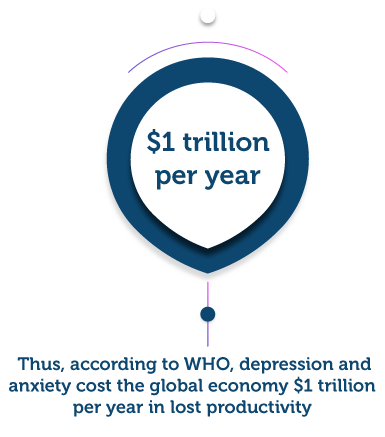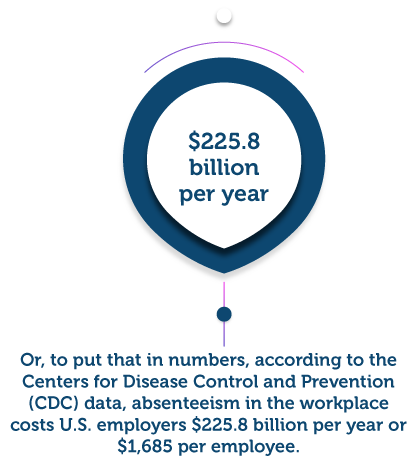
Fixed Mindset vs. Growth Mindset in the Workplace
Understand the key differences between a fixed and a growth mindset to foster a culture of development and adaptability at work.


Co-Owner & Marketing Director of EMUCoupon

Founder of MCA Assessors

Chief Marketing Officer at ProofHub

Employsure
Absenteeism in the workplace is an issue that HR professionals and employers constantly face. The prolonged and often unintentional absence can result in higher costs for employers and companies and drop morale and productivity.
In collaboration with managers and professionals, this article highlights the reasons behind absenteeism in the workplace. Moreover, we’ll focus on how much it costs companies to manage this condition and how it can be successfully addressed.
Absenteeism refers to an employee’s frequent absence from work for planned (intentional) and unintentional reasons. While a certain number of days off are tolerated in most companies, the issues occur when employees are frequently absent from work for longer periods.
HR professionals and organizations can estimate the absence rate in the company by analyzing the ratio of workers with absences to total full-time wage and salary employment. The U.S. Bureau of Labor Statistics data in 2021 shows a total absence rate of 3.2 and a total rate of lost work time rate of 1.9. Observed by occupations, the data clearly shows the highest absenteeism rates among management, professional-related occupations, service, sales professions, and more.

Another survey from Statista among 80% of respondents who worked or studied showed that one-third of them did not take any sick days from 2020 until 2021. Those who took some time off due to illness were absent for 2-3 days.
In general, regarding the reasons for taking time off work, there are several types of absenteeism:
Each employee has different reasons to be absent from work.
Therefore, there are numerous causes of absenteeism in the workplace. However, some of the most common reasons that contribute to frequent avoidance of the workplace include:
Mental health issues – Unaddressed mental health issues in the workplace affect individuals, companies, and organizations. Thus, according to WHO, depression and anxiety cost the global economy $1 trillion per year in lost productivity. Moreover, mental health statistics pinpoint depression as the leading cause of absenteeism. Still, the stigma around mental health issues, especially in the workplace, puts even

Chronic health issues – Illnesses, injuries on the job or outside of work, medical appointments, and chronic health problems are some of the most common reasons for employee absenteeism. While some are unplanned and translate as a few days off work, other chronic issues such as arthritis, diabetes, neck problems, heart diseases, and more imply increased absenteeism.
Workplace bullying or harassment – Any form of harassment at the workplace, bullying, or mobbing can increase absenteeism rates. These can create a hostile atmosphere at work, causing employees to avoid going to work.
Stress, burnout, or anxiety – Heavy workload, issues at work and outside the workplace, stressful situations, and tight deadlines can affect employees. Some studies and surveys on stress in the workplace show how mental health and physical health issues can cause high turnover rates and a drop in productivity for employers.
Child or elder care – When an employee takes care of a child or an older adult, they can take days off if the dependent is ill or another unplanned issue occurs. This is even more frequent in organizations that don’t offer flexible work opportunities.
Job hunting – Employees unhappy with the working conditions or who want to change their jobs may call in sick when looking for a new job. They often use days off to attend job interviews, meet with a recruiter, or work on their applications and resumes.
Low morale and engagement – Workplace absenteeism is high among dissatisfied employees. Feelings of being unappreciated, undervalued, and disrespected can lower employee morale and engagement resulting in missing and, ultimately, quitting work.
There are numerous negative effects of frequent absenteeism in the workplace that can affect other employees and the entire organization. Most commonly, absenteeism has a negative influence on businesses such as:
Since absenteeism is a complex issue, there isn’t a one-size-fits-all solution.
Often, addressing the absence in the workplace would mean taking an individual approach to each employee. However, several strategies can help HR teams and organizations reduce employee absenteeism.
These involve:
Implementing a well-structured and written attendance policy is crucial for addressing absenteeism in the workplace. HR professionals and employers must set and communicate clear rules and expectations in the workplace and ensure all employees are familiar with them.
All employees should know what types of leave the policy covers, including PTO, sick and bereavement leave, and more. They should also be aware of what behavior qualifies as absenteeism.
However, this policy shouldn’t be too strict since it can backfire as presenteeism – when employees come to work when they are sick or unable to do their job.
Moreover, HR teams must monitor employees and their time at work through absenteeism spreadsheets, weekly time reports, or time and attendance systems. Most importantly, they should address absenteeism issues as soon as possible.
Elice Max, the Co-Owner & Marketing Director of EMUCoupon, shared their experience with the absence management policy:
“There’s a clear attendance policy in our organization that outlines how issues such as early outs, no call-no shows, tardiness, and other types of leaves will be handled. There’s also a progressive discipline policy for attendance infractions. Recently, we have added mental health holidays to our policy as well.”
“One thing that has worked for us is rewarding employees with good attendance records. When employees see the punctual and regular workers being recognized and praised, they are motivated to develop these habits. There’s little cost associated with this activity, but the returns are extraordinary,” she added.
Vartika Kashyap, Chief Marketing Officer at ProofHub, continued: “As a firm, make sure you establish clear attendance policies. Attendance rules, entry times, break times, and exit times, among other things. To reduce the negative effects of absenteeism at work, having a clear attendance policy is essential. These regulations ensure that employees are aware of working hours, their importance, and the need to adhere to deadlines.”
The COVID-19 pandemic has changed the workplace for good. The hybrid work model is now the new norm in many companies. It offers possibilities for the employees to work in the hours and the location they prefer. Essentially, this flexibility allows employees to create the workday around their other off-work responsibilities, leading to better work-life balance.
Another way of improving employees‘ work-life satisfaction, productivity, and overall well-being is organizing wellness initiatives and implementing wellness programs. Therefore, it is no surprise that up to 79% of employees in a 2021 Statista survey believed that their company‘s wellness programs made them more productive and prevented them from getting sick.

By organizing regular meetings with employees, HR reps and managers can not only find the reasons behind the frequent absences but can also create better relationships with the team members.
HR reps and managers can get a bigger and clearer picture of the organization when showing genuine interest in employees’ workload, issues, and challenges.
It’s not uncommon for employees with good attendance to complete the tasks of those absent, ultimately resulting in frustration, a drop in morale, and burnout.
Thus, instead of focusing on penalties, many companies choose rewards to encourage good employee attendance. Still, it’s very important not to exclude employees with genuine and legitimate absences when implementing a system like this.
Highly engaged employees who are a part of an environment that fosters a teamwork culture are less likely to be illegitimately absent. Investing in employee training and development, knowledge sharing, providing feedback, and recognition are ways companies can empower their workers and create loyal and engaged workers.
“Train your staff to perform multiple roles,” said Marc De Diego Ferrer, the founder of MCA Assessors.
“If you experience high absenteeism rates, train your workforce to take on additional roles to fill in for absent workers. If an employee is absent for a day, you may delegate their responsibilities to the rest of the staff, but you could hire temporary workers to fill in for them if they are absent for an extended period.
It is essential to communicate regularly with your staff about when they are expected to resume work and how often they might experience unexpected absences to avoid confusion or frustration.”
Matthew Bridges from Employsure agreed with the integrative approach to addressing absenteeism:
“Dealing with absent or on long-term sick leave employees needs a proactive and sensitive approach. Due to the strain long-term employee absence places on a business, employers may wish to act promptly to reduce the negative effects associated with absenteeism. However, dismissing an employee on sick leave may expose the business to adverse action or disability discrimination claims.”
He continued:

Regular absences in the workplace or chronic absenteeism affect companies and organizations the most, resulting in disruption of the workflow and the workload, demotivation of the present employees, and an overall decrease in productivity.
Hence, a decrease in revenue, too.
Or, to put that in numbers, according to the Centers for Disease Control and Prevention (CDC) data, absenteeism in the workplace costs U.S. employers $225.8 billion per year or $1,685 per employee.
These costs come from employee wages payments to absent employees, overtime payments for other employees or costly replacement workers, administrative costs. But besides these financial costs, there are many indirect costs like poor production quality, high turnover rates, low morale and productivity, increased safety issues, and more.

Absenteeism in the workplace, regardless of its cause, can have a major impact on companies and organizations. When frequent and illegitimate absences outweigh the inevitable ones, it translates as a loss in profits and productivity and low employee morale.
However, employers are constantly finding new ways to mitigate the negative effects of absenteeism through absenteeism policies, reward systems, wellness programs, and more.
Browse our curated list of vendors to find the best solution for your needs.
Subscribe to our newsletter for the latest trends, expert tips, and workplace insights!

Understand the key differences between a fixed and a growth mindset to foster a culture of development and adaptability at work.

Explore the implications of well-being perks in the workplace by comparing ROI vs. VOI, the effectiveness of these two metrics, and which is better for measuring the benefits of employee wellness programs.

Explore crucial employee wellness statistics to enhance workplace well-being and productivity.

As wellness stretches beyond being physically fit, companies are straying away from traditional programs and trying a more holistic approach with their corporate wellness offerings.
Used by most of the top employee benefits consultants in the US, Shortlister is where you can find, research and select HR and benefits vendors for your clients.
Shortlister helps you reach your ideal prospects. Claim your free account to control your message and receive employer, consultant and health plan leads.